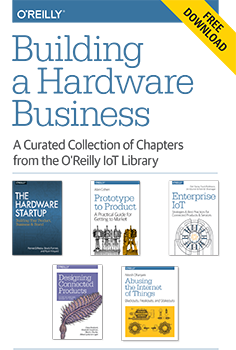Download a free copy of “Building a Hardware Business,” a curated compilation of chapter excerpts from our IoT library.
Over the last few years, we’ve seen an astonishing change in what it takes to build a hardware business. Hardware remains hard — executing it well requires technical and marketing expertise in several fields — but the barriers that startups must cross have been lowered considerably.That change has come about as a result of several changes in the way the market approaches hardware.
- Customers, whether consumers or businesses, have become aware of what hardware and connected devices can do for them. The Internet of Things means more than connected refrigerators now. For consumers, it represents desirable products like the NEST thermostat and Apple Watch. For managers, it represents the highest standards of informed decision-making and operational efficiency in everything from delivery fleets to heavy machines to simple design-driven data.
- Connecting with those customers has become easier. Startups can sell directly to niche consumers through online channels with the help of Etsy, Tindie, and ShopLocket, which are vastly easier to deal with than big-box retailers. These platforms also return rapid market feedback and offer ways for companies to connect with their consumers and build communities without intermediaries.
- Funding has become available through new mechanisms at every stage. Crowdfunding helps entrepreneurs test their ideas in the marketplace and raise enough money for early development. Venture capitalists, impressed by recent exits and aware of the vast green fields awaiting the Internet of Things, are willing to invest. Supply-chain managers like PCH are willing to take equity stakes in return for invoice financing, addressing a critical cash-flow challenge that can be a big barrier to startups looking to have products manufactured in large quantities.
- Technological developments have made prototyping easier and have eased the process of moving from prototype to manufacturable design. 3D printers get a lot of attention, but low-cost, high-quality CNC machines like the Othermill are arguably even more powerful: they can be used for small-run production, and they resemble their industrial cousins well enough that a design developed on the prototyping bench can move smoothly to large-run production. Modular electronics coupled with cloud services — like those from Spark Labs (disclosure: Spark Labs is a portfolio companies of O’Reilly AlphaTech Ventures), Electric Imp, and Temboo — cut out many difficult engineering steps during prototyping and can be used in production. Platforms like these also make it possible to offload key functionality to software running in the cloud. As a result of all these changes, the cost of developing a consumer-electronics prototype has fallen 25-fold in a decade, by some estimates.
- The manufacturing environment, thanks particularly to the rise of China’s electronics industry, has become more flexible and better suited to rapid product development. Manufacturers are willing to take small orders in order to establish a relationship with the next big thing. Components that are used in mobile phones — cameras, LCD displays, and accelerometers — have become cheaper by one to three orders of magnitude in the last decade. And when products are done, drop-shipping directly to customers keeps costs down.
All of this has created a business model for hardware that shares some key characteristics with the model for software. It’s getting easier to develop products rapidly, test them in the marketplace, and revise them. Thanks to cloud software and ubiquitous connectivity, companies can sell hardware as a service, as DropCam and Sight Machine have done (disclosure: Sight Machine is a portfolio companies of O’Reilly AlphaTech Ventures).
Companies need excellent technology and excellent business strategies to take advantage of these changes. That’s why we’ve developed our Solid Conference as an “anti-disciplinary” gathering of technologists and business people: to be successful, each side must understand the other thoroughly.
That will become clear in these excerpts from our new catalog of hardware-oriented books. I hope you’ll develop a sense of the complexity behind hardware, and a sense that that complexity is approachable.
Our free compilation, Building a Hardware Business, includes excerpts from these books:
The Hardware Startup, available in early release
Chapter 1: The Hardware Startup Landscape
Chapter 2: Idea Validation and Community Engagement
Prototype to Product, available in early release
Chapter 1: The 11 Deadly Sins of Product Development
Chapter 2: How Products Are Manufactured
Enterprise IoT, available soon in early release
Chapter 1: Overture
Chapter 2: Enterprise IoT
Chapter 4: Manufacturing and Industry
Designing Connected Products, available in early release
Chapter 4: Product/Service Definition and Strategy
Abusing the Internet of Things, available in early release
Chapter 1: Lights Out: Hacking Wireless Lightbulbs to Cause Sustained Blackouts
Chapter 2: Electronic Lock Picking: Abusing Door Locks to Compromise Physical Security

